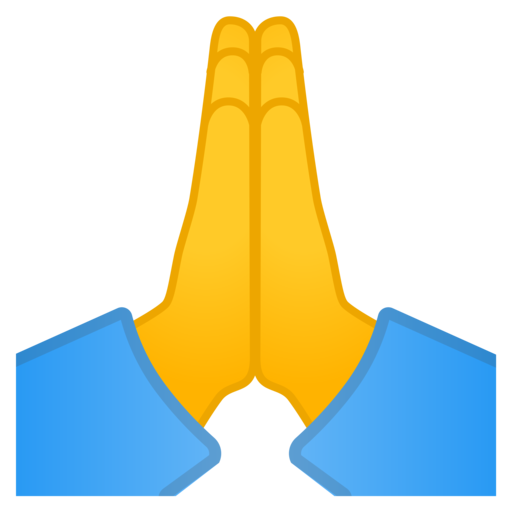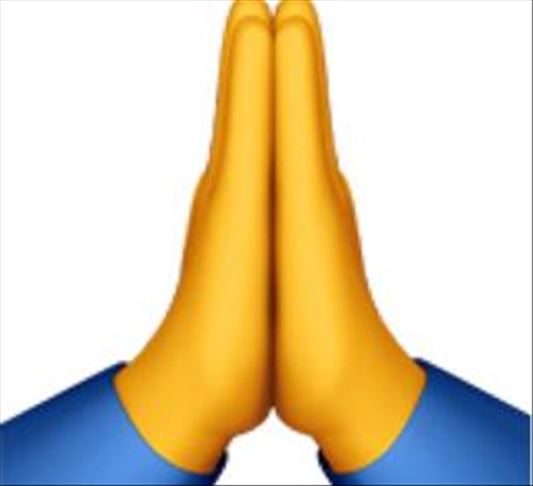What Does the Praying Hands Emoji Mean?
The praying hands emoji (🙏) is one of the most widely used symbols in digital communication, often appearing in messages of gratitude, prayer, and support. But does it truly mean prayer, or is it just a respectful gesture? The meaning of this emoji changes based on context, culture, and personal intent.
Imagine receiving a text that simply says:
“Thinking of you 🙏”
Is the sender praying for you, thanking you, or just showing support? The answer depends on various factors, including religious beliefs, regional customs, and even the platform displaying the emoji.
Let’s break down the true meaning behind the praying hands emoji and explore its deep cultural and spiritual significance.
Origins of the Praying Hands Emoji
The folded hands emoji (🙏) was introduced in Unicode 6.0 in 2010 under the name “Person with Folded Hands.” It was initially designed to represent prayer and gratitude, but its interpretation quickly evolved.
- Japan’s Influence: Some believe the emoji was inspired by the traditional Japanese “Gassho” (合掌) gesture, a sign of respect, apology, or gratitude. In Japan, this gesture is commonly used when saying “Thank you” (Arigato gozaimasu) or “Please” (Onegaishimasu).
- Christianity & Prayer: In Western cultures, folded hands symbolize prayer and devotion, commonly associated with Christian faith. Many religious artworks and sculptures depict this posture as an act of worship.
- Hinduism & Buddhism: In India, folded hands are known as “Anjali Mudra”—a universal sign of respect and greeting used in both Hindu and Buddhist traditions. The phrase “Namaste” is often accompanied by this gesture.
Common Interpretations of the Praying Hands Emoji
The meaning of 🙏 varies depending on the context. Here are the most common ways people use this emoji:
1. Prayer & Religious Devotion
The most straightforward interpretation is prayer. Many users send this emoji when:
- Expressing faith and devotion in religious conversations.
- Requesting or offering prayers for someone facing challenges.
- Mentioning church, temple, or spiritual practices in a message.
Example:
“Sending prayers for your recovery 🙏”
2. Gratitude & Appreciation
In non-religious contexts, the praying hands emoji often means “Thank you” or “I appreciate it”.
- Used in polite messages thanking someone for help or kindness.
- Commonly seen in customer service or social media replies.
- Expresses deep gratitude without needing extra words.
Example:
“Thank you for your support! 🙏”
3. Support & Encouragement
It’s also used to show solidarity, hope, or emotional support.
- When comforting someone going through a difficult time.
- When expressing good wishes for an upcoming event.
- When encouraging someone before a big challenge or test.
Example:
“Wishing you all the best in your exam 🙏”
4. A High-Five?
A surprising but common misinterpretation is that this emoji represents a high-five. While it visually resembles two hands clapping together, Unicode officially confirms it as folded hands, not a high-five.
Example of misuse:
“Great job on the presentation! 🙏” (intended as a high-five, but may be confusing)
Cultural and Religious Significance of the Praying Hands Emoji
While the 🙏 emoji is often associated with prayer, its meaning shifts across different cultures and religions.
Christianity and the Symbolism of Prayer
In Christianity, folded hands are a powerful representation of:
- Devotion and Worship – The traditional way of praying to God.
- Seeking Blessings – Asking for divine guidance or protection.
- Faith and Humility – Bowing in prayer is a sign of respect and surrender to God’s will.
Biblical Reference:
“Therefore I tell you, whatever you ask in prayer, believe that you have received it, and it will be yours.” — Mark 11:24
In Catholic traditions, the praying hands posture is also seen in depictions of saints and religious icons, reinforcing the emoji’s association with prayer and faith.
Eastern Culture: Namaste and Anjali Mudra
In Hinduism and Buddhism, folded hands hold spiritual and philosophical meaning beyond just prayer.
Namaste (Hindu Culture)
- A greeting of respect meaning “I bow to you.”
- Commonly used when meeting elders, teachers, or spiritual leaders.
- Signifies inner peace and divine acknowledgment.
Anjali Mudra (Buddhist Traditions)
- A hand gesture of meditation and mindfulness.
- Used during Buddhist rituals and chants.
- Represents balance, unity, and gratitude.
Example:
In yoga practice, instructors often say “Namaste 🙏” at the end of a session, reinforcing harmony and respect.
Other Cultural Meanings of the Praying Hands Emoji
Different countries and societies adapt the emoji for unique meanings:
| Country | Meaning |
|---|---|
| Japan | Apology, respect, or “Please” |
| Thailand | Traditional greeting (Wai gesture) |
| Korea | Asking for a favor or thanking someone |
| Middle East | Gesture of humility and submission |
In Japan, you’ll often see the 🙏 emoji used in restaurant reviews as a polite way of saying “Thank you for the meal.”
Example:
“Delicious ramen! 🙏”
Final Thoughts Before the Conclusion
The praying hands emoji (🙏) is one of the most versatile symbols in modern digital communication. While originally intended to represent prayer, it has taken on a broader meaning that includes gratitude, respect, support, and cultural traditions.
However, due to regional and cultural differences, it’s important to understand the context before using it. Is the person you’re messaging religious? Are they from a culture where this gesture has a different meaning? These small details can make a big difference in ensuring effective and respectful communication.
👉 In the second half of this article, we’ll dive deeper into emoji misinterpretations, digital trends, and how to use the praying hands emoji effectively across different social media platforms. Stay tuned!
Misinterpretations and Controversies Around the Praying Hands Emoji
Despite its widespread use, the 🙏 emoji has been subject to misinterpretation and controversy, particularly due to cultural differences and platform variations. Many users have debated its true meaning, with some even mistakenly believing it represents a high-five rather than a gesture of prayer or gratitude.
Is It a High-Five or a Prayer?
One of the most persistent misunderstandings is whether the folded hands emoji symbolizes a prayer or a high-five.
This confusion arises because:
- The visual design on some platforms makes it appear as two hands coming together.
- People often use it in celebratory contexts, thinking it represents two hands clapping.
- Some misinterpret the emoji due to a lack of cultural awareness regarding prayer and traditional greeting gestures.
Unicode officially classifies 🙏 as “Folded Hands,” reinforcing that its intended use is prayer, respect, or gratitude, rather than a high-five.
📌 Fact: The Apple iOS version of the emoji shows a small shadow between the hands, making it clear that they are not separate, while older Android versions previously depicted them differently.
Differences in Meaning Across Cultures
The meaning of folded hands varies significantly depending on the region and cultural background:
| Culture/Region | Meaning of 🙏 Emoji |
|---|---|
| United States & Western Countries | Prayer, gratitude, or support |
| Japan | Apology, request, or appreciation |
| India & South Asia | Namaste (greeting) or religious devotion |
| Thailand | Wai gesture (respect and greeting) |
| Middle East | Humility and religious connection |
💡 Example: If someone from Japan sends 🙏 in a conversation, they may be saying “I’m sorry” rather than praying. Similarly, if a Thai person uses it, they might simply be greeting you formally rather than expressing religious faith.
Praying Hands Emoji in Social Media and Digital Communication
The folded hands emoji is used widely across various social media platforms, each with subtle differences in how it appears and is interpreted.
How Different Platforms Display the Praying Hands Emoji
Each operating system and social media platform renders the 🙏 emoji slightly differently, which can affect its meaning in conversations.
| Platform | Appearance & Interpretation |
|---|---|
| Apple (iOS) | Hands touching, yellow skin tone by default, shadow for depth |
| Google (Android) | Similar to Apple, but without distinct shadows |
| More detailed, with realistic fingers and palm lines | |
| Facebook & Messenger | Simple flat design, less three-dimensional |
| Twitter (X) | More stylized, sometimes appearing as a single unified hand gesture |
📌 Tip: If you’re using the 🙏 emoji in a cross-platform conversation, remember that the visual appearance may differ, leading to unintended misinterpretations.
Popular Trends and Hashtags
On social media, the praying hands emoji is often seen in inspirational, spiritual, and motivational posts. Some of the most popular hashtags associated with this emoji include:
- #Blessed – Used in posts about gratitude, good fortune, or life reflections.
- #ThankYou – Common in appreciation messages.
- #Prayers – Frequently seen in messages offering support in times of crisis.
- #Faith – Used in religious and faith-based discussions.
📌 Example: On Twitter, users often write:
“Sending love and strength to those affected by the earthquake 🙏 #Prayers #Support”
Alternative Emojis to Express Gratitude and Prayer
While the folded hands emoji is widely used, there are several other emojis that can be used in similar contexts, depending on tone and meaning.
When to Use Other Emojis
| Emoji | Meaning & Best Use Case |
|---|---|
| 🤲 Open Hands | Often used in Islamic prayer and spiritual reflection. |
| 🛐 Place of Worship | Specifically denotes religion, church, or temple visits. |
| 🤝 Handshake | Expresses agreement, respect, or unity. |
| 👏 Clapping Hands | Better for celebration or applause, not gratitude. |
| 🙌 Raising Hands | Used to express excitement or praise rather than prayer. |
📌 Example: If you want to say “thank you” in a business email, using 🤝 instead of 🙏 might be more professional and clear.
Conclusion
At FEC Vietnam, we understand the power of emojis in modern communication and strive to provide the most accurate and culturally aware interpretations. The praying hands emoji (🙏) is more than just a digital symbol—it carries deep religious, cultural, and emotional significance worldwide.
However, as we’ve explored, its meaning is highly dependent on context:
- In Western cultures, 🙏 is primarily seen as a symbol of prayer, gratitude, and support.
- In Eastern traditions, it often represents respect, greeting, or even an apology.
- Social media and platform design variations can lead to misunderstandings, especially between users from different backgrounds.
Final Takeaways
- Context is key – Understand who you’re communicating with before using the 🙏 emoji.
- Not a high-five – Despite misconceptions, Unicode defines it as folded hands, not a celebration gesture.
- Consider alternatives – If you want to express gratitude in a professional setting, other emojis might be clearer.
- Be mindful of cultural differences – The emoji has different meanings in Japan, India, Thailand, and the Middle East.
At FEC Vietnam, we keep you updated on emoji trends, changes, and evolving meanings to ensure you use them correctly and effectively in your digital conversations. Whether you’re expressing gratitude, sending prayers, or showing respect, mastering emoji etiquette can enhance your online communication and help you avoid misunderstandings.
💡 Want to learn more about emoji meanings? Visit our website at FECVietnam.edu.vn for the latest insights and updates on digital communication trends!


